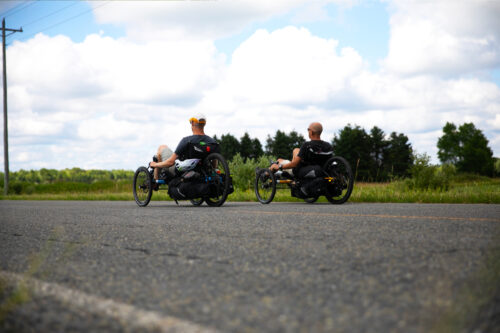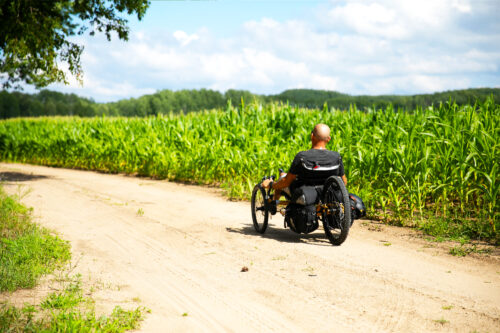
All About Tires: How to Assess Wear and When to Upgrade
June 24, 2022
Do you rarely think about your tires, or think about them entirely too much?
We admit to maybe being guilty of the latter here at TerraTrike. Is it because trikes have more tires than bikes? Perhaps.
If you ride enough, there is bound to be a time when tires will be top of mind – because flat tires stand in line just behind death and taxes in unfortunate certainties. But if you’re properly prepared, a tire problem shouldn’t ever be more than a minor inconvenience. And if you need new tires, we’ll help you pick what’s best for you down below.
This post will address issues pertaining to tires with inner tubes, as that’s how we set up all TerraTrike models for the time being. If you’ve converted your trike to tubeless, we’d love to hear how it’s going, so definitely drop us a line on social media.
So here’s a rundown on the most common tire problems and what to do about them.
Garden variety puncture
Maybe it was a piece of glass, a screw, a thorn or a little length of wire. Whatever it was, it penetrated your tire’s tread and inner tube, and now you’re stuck with a flat. Console yourself with the fact that you can repair two of the three tires on your trike without removing the wheels – the poor bicycle people always have to remove a wheel to repair a flat.
The most important thing here is to make sure you’ve located and removed the thing that caused the puncture. The simplest way is to run your fingers along the inside of the tire casing until you feel something poke your finger. Be careful and go slow, it could be sharp.
But sometimes you can stop a puncture before it gets that far. Before a long ride, it’s a great idea to carefully inspect your tires for small, embedded pieces of glass and other debris. Often they’ll penetrate the tread without yet getting through the casing, and you can pick them out with your fingernails, a sharpened spoke or a safety pin. Crisis averted!
For an in-depth instructional video on how to replace an inner tube on a bicycle tire, look HERE, from the experts at Park Tool. It’s all relevant to trike tires with the exception of wheel removal, as only a rear-wheel flat necessitates wheel removal for all TerraTrike models.

Snakebite or pinch flat
This kind of flat is characterized by two tiny holes in the inner tube only, right next to each other, without any puncture in the tire. It’s called a “snakebite” because that’s what it looks like. It’s called a “pinch flat” because pinching is what causes it.
Pinch flats happen when the inner tube is pinched hard between the trike wheel and some part of the road surface. Running tires at low air pressure while riding bumpy, rocky or pothole-heavy terrain is a recipe for pinch flats.
To reduce the chances of getting pinch flats, keep tires inflated at or near the maximum inflation pressure indicated on the tire sidewall. If your riding often includes lots of broken pavement or big, chunky gravel, it may be helpful to upgrade to a tougher, larger volume tire, or better yet, a trike designed from the ground up to handle the rough stuff … like the TerraTrike All Terrain!

Slashed sidewall
A little cut in a tire’s sidewall is a flat tire waiting to happen. The pressure of the inner tube inside will eventually cause a little bit of tube to bubble out of the sidewall kind of like, well, it’s gross, but like a hernia. The moment that soft little bit of exposed inner tube bubble is abraded by anything, it’s going to cause a flat.
A quick, regular inspection of your tire sidewalls is the best way to head off this potential problem. Small sidewall cuts can be repaired with some kind of boot material that creates a barrier between the tire sidewall and the inner tube. Lots of different kinds of boot kits are available for sale, but our favorite tire boots are empty energy gel packets and folded dollar bills.
A boot job will usually get you home, but don’t trust it for long-term riding. You’re going to want to replace that tire.
Instead of it being a grudge purchase, we recommend using a slashed sidewall as an excuse to facilitate a full, 3-tire upgrade to something fast, fun and sexy, like the GreenSpeed Scorcher – you’ll be faster, smoother, and hey … you only live once.
Excessive tread wear
Starting to notice a flat spot down the center of that tire tread? It’ll most likely happen on the rear first, but either way, if you’re almost down to the threads in the tire casing, it’s your lucky day, because you’ve earned the right to pick out new tires! Worn tires are much more vulnerable to punctures and adversely affect the handling of your trike.

Choosing Your Tires
Here’s a few of our top picks depending on your riding needs.
Durability – Our choice here would be the Schwalbe Smart Sam. The thick tread on the Smart Sam helps keep your wheels turning through even the roughest terrain (and is why we use it on the All Terrain).
Puncture Resistance – The Schwalbe Marathon is perfect for cruising on long tours, and its medium tread helps avoid punctures from jagged stones or broken glass.
Speed – Schwalbe offers the Kojak and Pro One, which are sure to help you boost your speed. But if you’re chasing that new PR, few tires compete with the GreenSpeed Scorcher.
Have a favorite trike tire not mentioned here? Drop it in a comment and let us know what you like about it!

